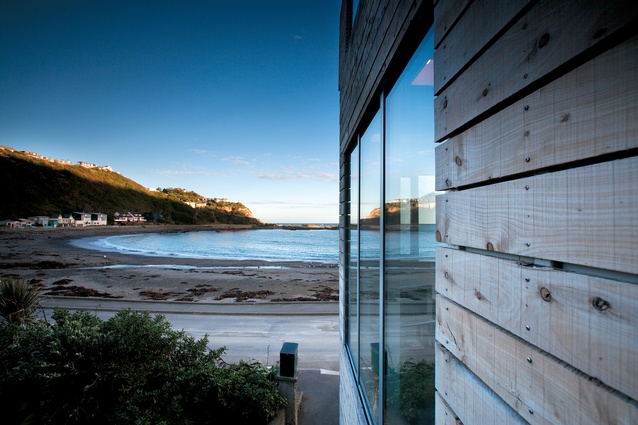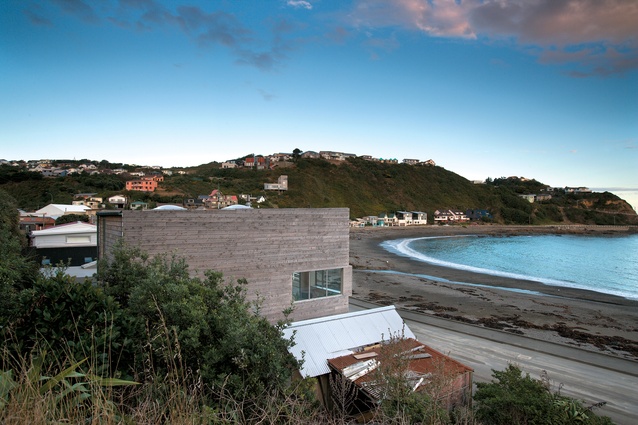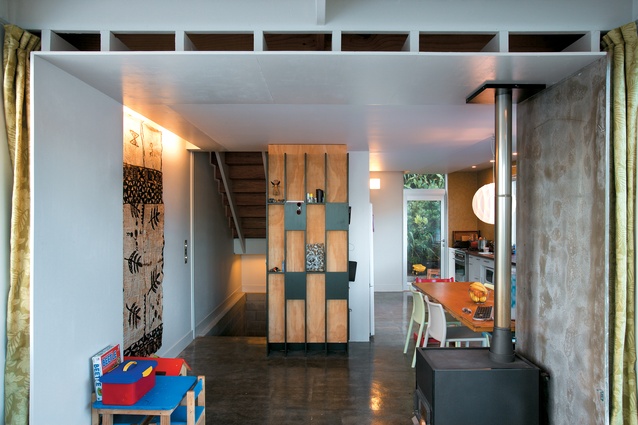Houses Revisited: Strait on
On Wellington’s wild southern shore Rafe Maclean has designed a brave little house for his family, first published in 2006.
Head south from Brooklyn in Wellington until the road runs out and you will find yourself at Ōwhiro Bay, the most westerly of the staunch South Coast bays – places that turn their backs on the city, face Cook Strait and bravely take on the kind of weather the rest of us would much rather just watch on TV. Ōwhiro Bay might lack the fish and history of Island Bay and the surf beach breadth of Lyall Bay, but it has its own defiant charm.
A line of truly rugged, south-facing houses stands in single file against the cliff rising above the bay. The newest house at Ōwhiro Bay stands erect and adjacent to the oldest, an early twentieth century concrete-walled bungalow. Rafe Maclean and Michelle Mitchell bought the bungalow seven years ago with the intention of building anew alongside it. Rafe enjoyed the process of designing for himself without the pressure of deadlines and with the luxury of living right next door. After designing many homes for others, he had a large library of ideas to draw on and, he says, the project was more about editing out than originating. The house is a result of Maclean’s meticulous tinkering.
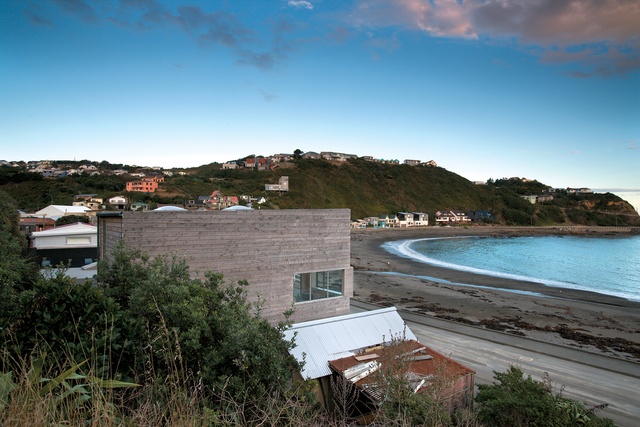
Narrow, tall, almost pinched, the Ian Louise house – named after an old boat once beached at the bay – stands and delivers. The exterior is clad in a loose skin of macrocarpa boards spaced apart, lending a bleached lightness to the blighted coast. Hiding behind the boards is a ground floor of concrete block. The short step from the garage floor to the entry prevents the waves that wash over the road in extreme southerlies from depositing debris inside the house.
The entry is a cunning and masterful use of space. There is a laundry behind a concealed door, nestled below the stair and, opposite, a coat cupboard behind sliding timber doors over a lumber store. From the woodpile the pungent scent of cut macrocarpa rises through the house. Directly opposite the entrance door, a large window frames a view of the existing concrete retaining wall, a reminder of the brutal site out of which this delicate box has grown. Maclean sees the house as a shell: crusty and rough on the outside, calcium carbonate smooth inside – a perception that was his guide in the design process.
The lightweight stair rises and turns, with light and air filtering between it and the whitewashed plywood walls. A panel in the landing lifts to reveal a wine cellar below, cool and concealed. The first floor is the heart of the house, the place where the living happens. A living room, barely 3.2m wide, extends out to the views of the sea. High sills to the south and west preserve views of the sea and the Kaikōura Range, maintain privacy from passers-by below, and provide walls to furnish against. Floor to ceiling windows to the east suck in the sun and deliver a view up the valley.
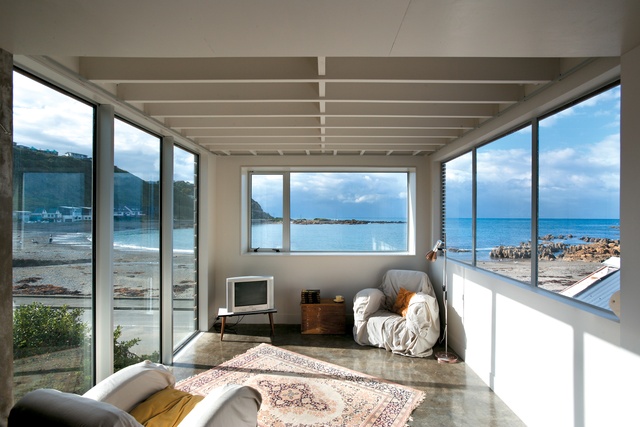
The living room is separated from the rest of the floor by a thin skin portal that at its edges houses the curtains that can encircle the room on cold nights. This portal also denotes the transition of the ceiling from the open joists of the floor above which are over the living area, to the flat ceiling of the dining and kitchen. Standing sentinel is the classic Pyro woodburner that supplements the underfloor heating that keeps the polished concrete floor warm to the touch.
The dining area slips in, bounded by louvres directly to the south and a bracing wall to the east clad in white twinwall PVC that makes the room glow. When open, the louvres amplify the sound of the waves crashing on the beach, seeming to bring them even closer. The kitchen is wide, as it is also the thoroughfare to the floor above. One side (tiled in ocean blue) is dedicated to cleaning; the other (with tiles of caramelised yellow) to cooking. The placement of a second, smaller sink close to the hobs means hot pans don’t have to be carried across the room. The stainless steel of the sink merges seamlessly with the blackwood bench which has a recess to the rear for bottles and condiments. It’s all simple, elegant, functional, and free. A back door leads to a tiny deck that slams into the cliff behind.
The stair winds around and up again to the bedrooms and bathroom. A small study (currently a changing table for a baby), bathed in light from a skylight, occupies the landing between the bathroom and the second bedroom. This bedroom gets views south through louvres to the sea and north to the cliff. The bathroom is roomy, with louvres and a view from the bath. A built-in unit forms the barrier to the hallway, forming the hot water cupboard (connected to the wetback on the woodburner and ready to receive solar energy from future panels). The bathroom floor is tiled the colour of sushi.
At the end of the hall-the end of the house-the main bedroom, like an eyrie, leers over the sea. The lighting is concealed and subdued; timber doors hide a wardrobe and a full-length mirror reflects the sea. Like the living room below, the end window has a high sill, made wide by a window that projects out of the planked façade. In a stiff wind the macrocarpa sheath whistles and shudders like a boat.
With a floor plate of 50m2 the house is compact and efficient, light and delicate. Every nook and cranny is occupied. The Ian Louise house combines an urban sophistication with a coastal attitude, creating a warm home in a harsh environment. Wedged between cliff and sea, the house rises up and stakes its claim to its tough and wonderful site.
Click here to see more Houses Revisited. And sign up to our email newsletters to receive Houses Revisited straight to your inbox.
Note: These are stories from our archives and, since the time of writing, some details may have changed including names, personnel of specific firms, registration status, etc.


